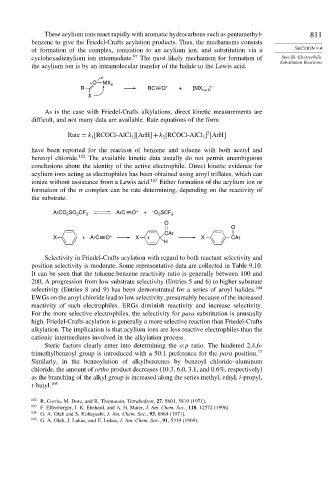Page 828 - Advanced Organic Chemistry Part A - Structure and Mechanisms, 5th ed (2007) - Carey _ Sundberg
P. 828
These acylium ions react rapidly with aromatic hydrocarbons such as pentamethyl- 811
benzene to give the Friedel-Crafts acylation products. Thus, the mechanisms consists
of formation of the complex, ionization to an acylium ion, and substitution via a SECTION 9.4
cyclohexadienylium ion intermediate. 97 The most likely mechanism for formation of Specific Electrophilic
Substitution Reactions
the acylium ion is by an intramolecular transfer of the halide to the Lewis acid.
+O MX n
R RC O + + [MX n+1 ] –
X
As is the case with Friedel-Crafts alkylations, direct kinetic measurements are
difficult, and not many data are available. Rate equations of the form
2
Rate = k RCOCl-AlCl ArH +k RCOCl-AlCl ArH
1 3 2 3
have been reported for the reaction of benzene and toluene with both acetyl and
benzoyl chloride. 102 The available kinetic data usually do not permit unambiguous
conclusions about the identity of the active electrophile. Direct kinetic evidence for
acylium ions acting as electrophiles has been obtained using aroyl triflates, which can
ionize without assistance from a Lewis acid. 103 Either formation of the acylium ion or
formation of the complex can be rate determining, depending on the reactivity of
the substrate.
ArCO SO CF 3 ArC O + + – O SCF 3
2
2
3
O
O
CAr
X + ArC O + X + X CAr
H
Selectivity in Friedel-Crafts acylation with regard to both reactant selectivity and
position selectivity is moderate. Some representative data are collected in Table 9.10.
It can be seen that the toluene:benzene reactivity ratio is generally between 100 and
200. A progression from low substrate selectivity (Entries 5 and 6) to higher substrate
selectivity (Entries 8 and 9) has been demonstrated for a series of aroyl halides. 104
EWGs on the aroyl chloride lead to low selectivity, presumably because of the increased
reactivity of such electrophiles. ERGs diminish reactivity and increase selectivity.
For the more selective electrophiles, the selectivity for para substitution is unusually
high. Friedel-Crafts acylation is generally a more selective reaction than Friedel-Crafts
alkylation. The implication is that acylium ions are less reactive electrophiles than the
cationic intermediates involved in the alkylation process.
Steric factors clearly enter into determining the o:p ratio. The hindered 2,4,6-
trimethylbenzoyl group is introduced with a 50:1 preference for the para position. 77
Similarly, in the benzoylation of alkylbenzenes by benzoyl chloride–aluminum
chloride, the amount of ortho product decreases (10.3, 6.0, 3.1, and 0.6%, respectively)
as the branching of the alkyl group is increased along the series methyl, ethyl, i-propyl,
t-butyl. 105
102
R. Corriu, M. Dore, and R. Thomassin, Tetrahedron, 27, 5601, 5819 (1971).
103 F. Effenberger, J. K. Ebehard, and A. H. Maier, J. Am. Chem. Soc., 118, 12572 (1996).
104 G. A. Olah and S. Kobayashi, J. Am. Chem. Soc., 93, 6964 (1971).
105
G. A. Olah, J. Lukas, and E. Lukas, J. Am. Chem. Soc., 91, 5319 (1969).

